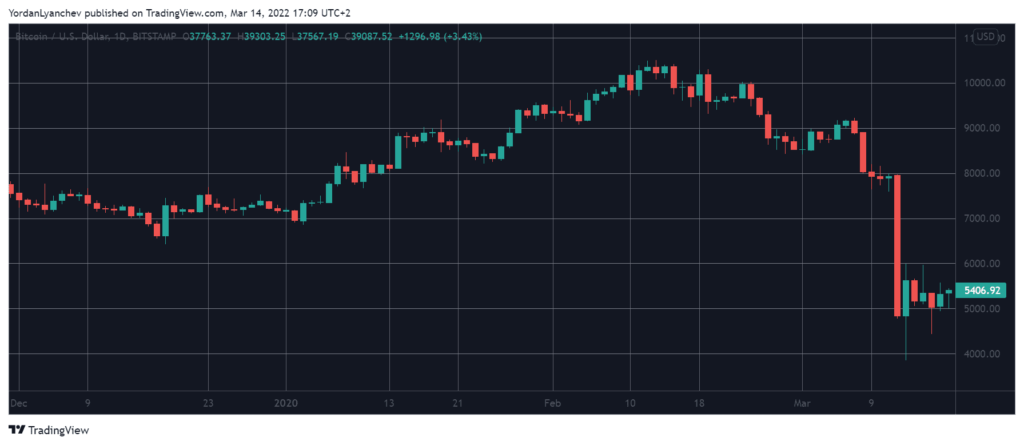
Last weekend marked the second anniversary of the notorious COVID-19-induced bitcoin crash in which the asset dumped by 50% in a day to below $4,000. While many naysayers rushed to declare BTC’s death (again), the subsequent 24 months turned out to be quite positive, given the fact that the asset added another zero to its USD price, was adopted by numerous institutional investors, and even legalized in a country.
What happened back then?
It’s been two years, but it almost feels like an eternity ago. A lot has changed since the beginning of 2020.
The start of the year was quite optimistic, especially for the cryptocurrency sector. Bitcoin entered January 1st at around $7,000 but quickly shot up and found itself trading above $10,000 six weeks later. The landscape with other (riskier) financial markets was similar, as the S&P 500 tapped a new all-time high.
Still, there was an imminent threat that was only known to a few (mainly Asian) countries. An unknown but hidden virus that supposedly originated from a bat in the Chinese city of Wuhan.
There weren’t too many people that could have anticipated the true impact of this virus on the whole world and everything that happened (and continues to happen) years later. In fact, only a handful in the West took this threat seriously initially, as there were only a few isolated active cases.
However, the situation became serious quite quickly. The virus was given a name and became a complete threat once the World Health Organization declared it a pandemic in mid-March 2020.
We won’t go into detail about the mass panic, especially the educational videos on how to wash your hands, the need for masks, hand sanitizers, and toilet paper. But, we will review what transpired in the crypto markets.
Bitcoin had already lost value and was trading around $8,000 on that historic day when it simply crashed, nosed over, dumped or whatever synonym suits it. the best. Within hours, the leading cryptocurrency lost over 50% of its value and fell below $4,000.

The altcoins saw even more substantial price losses. Fear and panic were everywhere. The traditional media was quick to proclaim BTC dead (again). In desperation, the community sought potential reasons behind this mayhem as gloomy predictions forecasted a three-digit price level soon, or even worse (Peter Schiff).
No, Bitcoin is not dead
As happened in over 400 other cases where someone declared bitcoin dead, the cryptocurrency proved them wrong. It hasn’t gone below $1,000, and it certainly hasn’t gone to $0.
Just the opposite, it started to recover its lost ground slowly but surely. It never looked back, and it traded at $8,000 less than two months later. It kept climbing in the following months, perhaps fueled by the down-described adoption and the third halving, and finished the year at almost $30,000.
As its price headed into uncharted territory, something (perhaps) even more impressive had begun – a process of transformation from several investors, many of whom had doubted and disparaged BTC before. Prominent legacy investors such as Paul Tudor Jones III, Stan Druckenmiller, Anthony Scaramucci and Ben Miller began leasing the asset and admitted to buying parts of it.

People like Kevin O’Leary, Jordan Belford, Ray Dalio, and Ken Griffin have completed a 180-turn by purchasing BTC or predicting six-digit price tags.
Another name, who dismissed the merits of BTC seven years prior – Michael Saylor – has become synonymous with the term Bitcoin Maximalist. He and his company began hoarding massive portions of BTC and now collectively own over $5 billion.
But it wasn’t just individual investors, as other institutions, such as MassMutual, One River Asset Management, and BlackRock, hopped on board. Even giant banks – the ultimate critics – came to play.
JPMorgan, whose CEO called BTC a “fraud”, now offers crypto services. Bank of America praises Solana, Chainlink, entire crypto industry, says BTC is “important.” Citigroup recently announced plans to expand its crypto team by hiring over 100 people.
Morgan Stanley says BTC is “not going away” and allows institutional investors to buy portions of the asset through several funds. BNY Mellon offers crypto custody and partnered with Grayscale to help with its Bitcoin ETF application. And the list goes on and on.
Even more adoption
Adoption these days comes in different forms. The number of companies allowing BTC payments has exploded over the past two years. From now on, you can use the main cryptocurrency (or other digital assets) to pay for movie tickets, buy fast food, buy cars and real estate, buy fashion goods, make a donating to charity, getting wine and just about everything else.
But perhaps the most notable adoption news came last year when El Salvador became the first-ever country to officially legalize bitcoin. The law came into effect in early September, and the government has launched multiple pro-BTC initiatives since then. Arguably the biggest and most ambitious one is the building of an entire city focused on the cryptocurrency.
So it’s safe to conclude that bitcoin didn’t die on March 12-13, two years ago, when everything changed. On the contrary, it began to flourish and became a widely recognized and accepted asset class, leading a multi-trillion dollar industry.


















